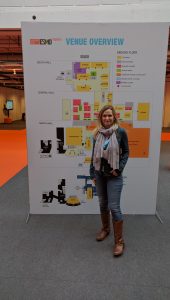 The media have a lot to answer for when it comes to mismanaging patients hopes and expectations. If you had been diagnosed last year with Melanoma, you might well have been full of buoyant hope & expectation. The hope is there…but it is mixed with a decent amount of trepidation…not just amongst patients…but direct from the mouths of the oncologists too…
The media have a lot to answer for when it comes to mismanaging patients hopes and expectations. If you had been diagnosed last year with Melanoma, you might well have been full of buoyant hope & expectation. The hope is there…but it is mixed with a decent amount of trepidation…not just amongst patients…but direct from the mouths of the oncologists too…
Melanoma is one of those wonderful & highly interesting disease areas for oncology. The very nature of how it works is a challenge…the way it mutates and adapts, the fact it is rare, like a battle or war to conquer…all eyes are on us.
This was no different at ESMO. When a new drug is conceived it is often done with 1 particular indication in mind. Soon through clinical trials and a whole lot of research other avenues and disease areas are explored…but generally it is the worst possible scenario that is tested first. If we can get X treatment to work on this…it could work for other areas too.
As a patient attending something like ESMO, I am something of a fish out of water. There was only 1 talk in layman’s terms. Thankfully, after the online course I did earlier this year on immunotherapy & all the other conferences I have attended, I actually felt like I knew what the speaker was talking about – my knowledge level now ahead of the basics.
But then I sat in on sessions that talked about biomarkers, about oncolytic viruses, gene signatures, circulating tumour DNA…and it becomes completely clear that this conference is going to keep me on my toes.
So…lets start at the beginning.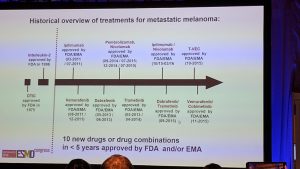
We Melanoma patients are lucky – this is a disease area that is leading the way at the moment with current new advances in drug treatments. There are 10 new drugs on the market in just the last 5 years – so the options that are available to us are improving beyond my wildest dreams 3 years ago when I was diagnosed.
Biology is not black & white – it isn’t simple – patients have different immune reactions & this brings it’s own challenge to oncologists. Especially with Melanoma, which has a greater mutational load than many other cancers – it evolves too quickly. So our oncologists need to really understand the environment & what factors affect the types of treatments each individual patient should have.
Our treatments are now based upon our own individual Immune systems & the genetic features present in our bodies at the point of diagnosis. So there was a call amongst many of the oncologists at ESMO that more needs to be done pathologically to help identify these genetic biomarkers. Currently there are only a few tests done routinely by every centre – such as whether a tumour is Braf+ & what the LDH level is. Cost impacts whether these tests happen & cost was a subject that came up many times.*glossary
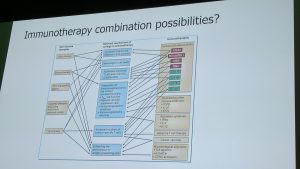 There are so many possibilities for Immunotherapy. Combination upon combination – with existing drugs & known inhibitors or activators on the market. There was some real excitement generated for a trial of Ippiluminab where they compared patient responses from those given 10mg (a standard dose) to those given a 3mg dose. Why did they do this trial – well simply because the drug has severe adverse effects at the 10mg dose & this prevents many patients from being able to continue to take it. The issue was that whilst the AE’s reduced at the lower dosage – so did the response rate. We learn from trials like this –however we are at a point now when we need to concentrate more of the efforts now on the unmet medical population. Combination therapies are not always the best option & quality of life is often overlooked in favour of results.
There are so many possibilities for Immunotherapy. Combination upon combination – with existing drugs & known inhibitors or activators on the market. There was some real excitement generated for a trial of Ippiluminab where they compared patient responses from those given 10mg (a standard dose) to those given a 3mg dose. Why did they do this trial – well simply because the drug has severe adverse effects at the 10mg dose & this prevents many patients from being able to continue to take it. The issue was that whilst the AE’s reduced at the lower dosage – so did the response rate. We learn from trials like this –however we are at a point now when we need to concentrate more of the efforts now on the unmet medical population. Combination therapies are not always the best option & quality of life is often overlooked in favour of results.
An individual approach is a good place to start. There is a chance now to get this right. One oncologist said it might well be too early to throw the “C” word out there – 10 years ago the “C” word was Cancer…now that word is “cure”. For some people who have been on a treatment that has completely removed all signs of Cancer from their bodies the word might be aptly used.
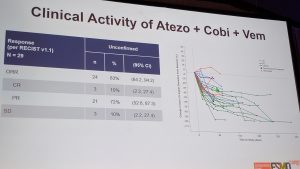 These new & exciting options bring some really significant advances. A “super-combination” trial with responses from 83% of patients – which one oncologist called astounding. There is also a trial called the Masterkey 265 trial which early data indicates a significant complete response rate & there was a presentation about a trial looking at something called the “Sting pathway” which is effectively a study of the signals released by the body as defence mechanism’s to protect the cancer from treatment.
These new & exciting options bring some really significant advances. A “super-combination” trial with responses from 83% of patients – which one oncologist called astounding. There is also a trial called the Masterkey 265 trial which early data indicates a significant complete response rate & there was a presentation about a trial looking at something called the “Sting pathway” which is effectively a study of the signals released by the body as defence mechanism’s to protect the cancer from treatment.
Its mind boggling, how to wade through this minefield of information & pick out anything that might potentially work. To identify something that isn’t just momentarily successful, but durable. It’s impossible not to feel hope when you listen to these amazing people talk about discoveries like they just plucked them off trees.
This hope…this overwhelming feeling of sitting on the precipice of a breakthrough is dangerous. We can’t get complacent, because what we are still looking at is just a 20% better survival & response rate now than we had 10 years ago. This, granted, is in itself, miraculous, but we mustn’t forget that these treatments only work on 50% of patients – there is still the most terrifying level of unmet need there.
This new level of learning has brought Melanoma treatment forward. We now understand acquired resistance (the resistance your cancer creates as it receives treatment-mutates) in a way we never did before. 5 years ago average survival post progression was 6-9 months, now we are looking at average survival figures of 3-5 years…for some lucky responders, even more. What we still don’t know enough about is innate resistance. Why do some patients just simply not respond to any treatment path?
We need to continue with our quest for more. I cannot begin to tell you how inspiring I find attending conferences like ESMO. It’s like brain overload one minute & then discovering there is still space on the memory card left. 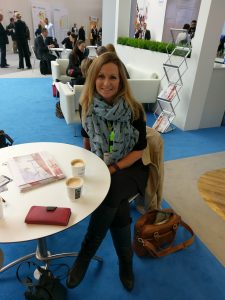
The progress continues. The options open up in the most unbelievable of ways. For a non-science person, I have never been so utterly captivated by the wonder of what scientific breakthroughs, in the hands of the right people, can achieve. These last 2 weeks I have been taking my son around secondary schools to plan for his future…and the facility I was judging these places by was the provision of science learning at the highest level.
A far cry from the girl who once nearly blew up a school science lab with a magnesium experiment that went wrong!
